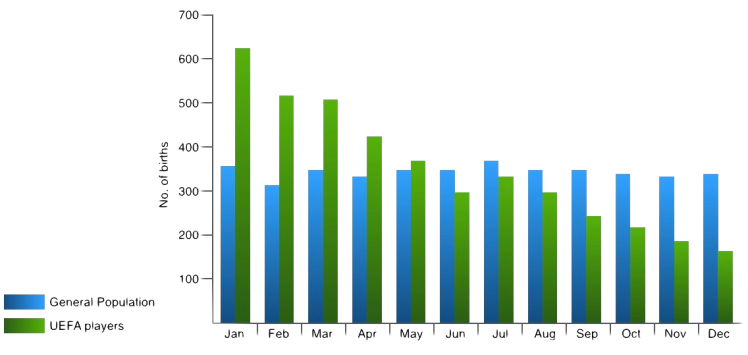![]()
The Relative Age Effect, commonly referred to as RAE, is a theory which suggests that children can be disadvantaged for the rest of their sporting careers, simply because of their month of birth.
The research indicates that children who are born at the beginning of a designated selection period, contribute a significantly larger proportion of young athletes who then go on to play at the elite level of their particular sport.
Put another way, it’s highly beneficial to be an older athlete within an age-range peer group, across a wide variety of sports.
Research
UEFA, like most other international governing bodies, use 1 January as the deadline for their youth tournaments. For example, to be eligible to play in an U17 age-group team, a player must be 16 years old on or before 31 December.
A study of 4,000 young international footballers involved in UEFA tournaments during the 2010/11 season, at U17, U19, and U21 level, revealed that there was a disproportionate number of players who were born in the early months of the year.

Numerous other studies, looking at different sports, highlight similar patterns, and there is also a strong body of research suggesting that people born closer to the cut-off date are more likely to subsequently become professional sports players.
Why does it occur?
It’s all to do with the disparity in maturation rates of young children. If we use the UEFA deadline as an illustration, a child born in January is 11 months older than a child born in December.
At younger ages, the effects of maturation is more pronounced – if these children were in the same U6 age-group, there would be a 17% difference in chronological age.
Within a sports context, it is likely that this older child would outperform the younger peer, simply because of being physically and emotionally more mature.
Consequently this may influence the talent identification process, with a chain of events being started by well-meaning coaches and parents, who provide additional training and playing opportunities to the older and “more talented” child, which then further increases the gap in performance levels.
On a cognitive level, the confidence of the younger child decreases, which can then lead to a belief system (in the child, coaches, and parents) that he or she is not naturally gifted for playing sport.
As a result, diminished confidence in the younger child reduces the enjoyment of playing the sport, leading to less time devoted to skill development, and thus a vicious circle is created.
Would you like to support my writing? Click here to find out more

This is an interesting phenomena because the smaller kids who do stick at it end up being better technically and mentally when they catch up in size. I am not sure how to fix it though. I saw one suggesting to swap the top and bottom three months allowing the smaller kids to become the bigger kids, but all that does is make the big kids from the next year down the smaller kids, even smaller than those they replace.
Actually, I am sure how to fix it… Coaches forget about winning and focus on performances. If it was good enough for Johan Cruyff, it should be good enough for the rest of us 🙂
LikeLiked by 1 person
Absolutely agree with you Vince 👍
LikeLike
Super interesting. I first read about this in a book by Malcom called “outliers: the story of success”. There are so many instances where this applies.
LikeLiked by 1 person
Yes, it’s a good book. Thanks for your comments!
LikeLike